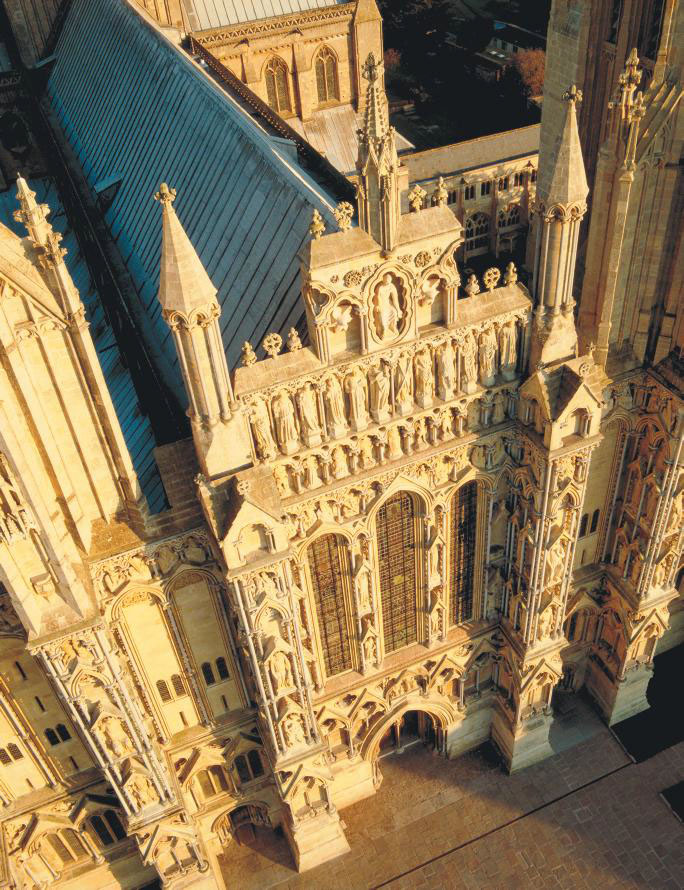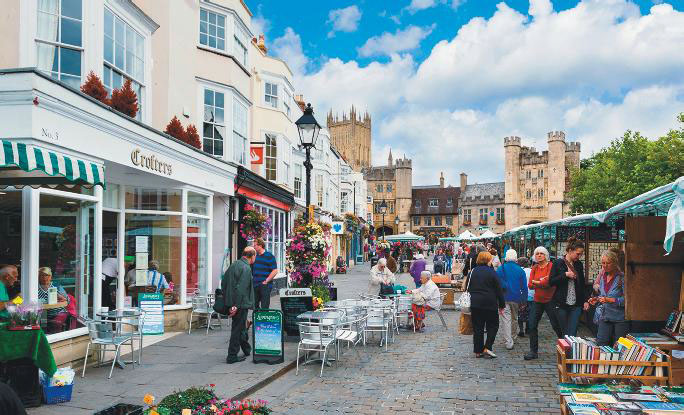
The medieval streets of Wells, in Someret.Needpix
Compact and picturesque Wells makes a great visit.
Welcome to medieval Wells—England’s smallest city. Tucked on the southern side of the Mendip Hills in rural Somerset, tiny Wells (population circa 12,000) owes its city status to 13th-century Wells Cathedral. It shares the Bishop of Bath and Wells with its more acclaimed neighboring city, Bath, some 20 miles to the north. While Wells attracts far fewer visitors than Bath, however, it feels more like a country market town than a city.
Make your way to the Mendip Hills
Part of Wells charm is its rather out-of-the-way location. The A39 leads south to Wells from Bath and Bristol. From the M5, catch the A39 east at Junction 23. Allow about 45 minutes either way. There is no convenient train service, but regional busses serve routes from Bristol or Bath.
Wells Cathedral
Like many cities such as Salisbury and Worcester, Wells grew around the foundation of its Norman cathedral, the first built in the new Gothic architecture. Construction of the cathedral took the entire 13th century, with its huge Scissor Arches added a century later. The cathedral’s west front is adorned with some 300 medieval statues and is thought the most impressive such façade in Europe. Among the cathedral’s famous features is the church’s 14th-century clock with a 24-hour clock face that works to its original mechanism, chiming out the quarter hours.

Some 300 medieval statues of saints and martyrs adorn the West Front of beautiful Wells Cathedral.
While many of England’s great old cathedrals are isolated in the sprawl of their contemporary cities, Wells physically retains its context. The original medieval complex remains intact, complete with chapter House, cloisters and picturesque moated Bishop’s Palace. The adjacent medieval cobbled vicar’s Close claims to be the oldest continually occupied street in Europe, and only completely medieval street left in the country. You might return to the cathedral at 5:15 p.m. to hear Wells’ famous choir sing choral evensong, its treble descants rising into the arches.
Puttering around in Wells
Adjacent to the cathedral, and open for visitors, the Bishop’s Palace has been the bishop’s residence for 800 years. Within its curtain walls, as well as Great Hall, chapel and private offices and apartments, there are 14 acres of gardens and arboretum. The wells, or springs, that give the city its name rise here and fill the moat.

Wells’ moated Bishop’s Palace encloses 14 acres of gardens open to the public.
Just outside the cathedral close, Wells Market Place comes to life every Wednesday and Saturday. The twice-weekly market has continued for centuries and still emphasizes local products and producers.
Like many local museums, the Wells Museum on the Cathedral Green began as a private collection of artifacts and curiosities. Its eclectic displays today retain that feeling of charming Victorian eccentricity and include everything from dinosaur fossils and Roman finds to exhibits on the local caves and the city art gallery.
To spend a night or two
Wells is blessed with several classic 3-star inn choices virtually adjacent to the cathedral close. The Crown at Wells, the Best Western Swan, and the White Hart Hotel are all comfortable, old inns that have character as well as convenience. These and other nearby options, including several local pubs and B&Bs, can be explored at www.wellssomerset.com Wells does make a great place to base a day or two’s exploration of Somerset.

The Market Place just outside the cathedral close bustles on Wednesday and Saturday.
For thirst and hunger
There’s no shortage of pubs and lunch options in the city center. Apart from hotel dining rooms, though, dinner options are limited in the immediate cathedral precincts. The bright, contemporary Italian chain Ask has a central spot in the Market Place. The City Arms, located in the old city jail on High Street, might be called a gastropub, with a moderately priced bistro menu highlighting locally sourced food. The Swan’s restaurant is fine dining; the more inform White Hart specializes in burgers.
In the neighborhood
To Wells south and west, the low, oft flooded Somerset Levels stretch for miles. Wells is right in the center for a day or two rambling around the nearby treasures of Somerset, whether you want to follow the trail of the Thankful Villages (September, p. 50) or explore Glastonbury, just down the road. The limestone escarpment of the Mendips hides a honeycomb of caves such as Wookey Hole and Cheddar. The cliffs and caves of Cheddar Gorge have drawn spelunkers and spectators for generations. Stop into the original Cheddar Cheese Dairy and watch the cheesemaking. Sample Scrumpy Cider Apple Cheddar and Pickled onion Cheddar as well as the mature cave-aged original they have been making since the 1800s.
Along the way
If you’re heading east toward Salisbury, the New Forest, and Winchester, take the A371 and visit Stourhead near Mere. “Flagship of the National Trust,” these are the quintessential 18th-century landscape gardens—spectacular any season of the year.
* Originally published in Nov 2014.





Comments